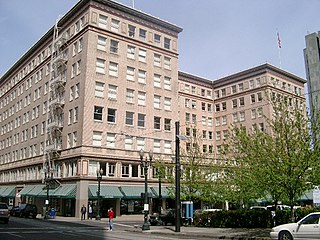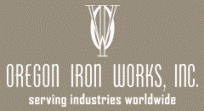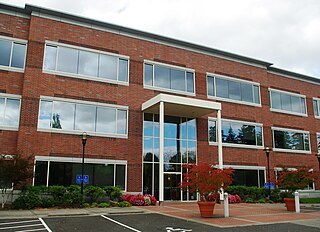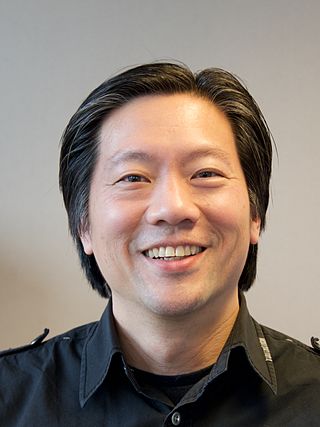
Silicon Forest is a nickname for the Washington County cluster of high-tech companies located in the Portland metropolitan area in the U.S. state of Oregon, and most frequently refers to the industrial corridor between Beaverton and Hillsboro in northwest Oregon.
Lattice Semiconductor Corporation is an American semiconductor company specializing in the design and manufacturing of low power field-programmable gate arrays (FPGAs). Headquartered in the Silicon Forest area of Hillsboro, Oregon, the company also has operations in San Jose, Calif., Shanghai, Manila, Penang, and Singapore. Lattice Semiconductor has more than 1000 employees and an annual revenue of more than $660 million as of 2022. The company was founded in 1983 and went public in 1989. It is traded on the NASDAQ stock exchange under the symbol LSCC.
Kyle C. Ranson is an American businessman who was the president and CEO of InFocus from August 2004 to May 2007. At the time, InFocus was headquartered in Wilsonville, Oregon. Kyle was originally hired as the executive vice president of worldwide sales and marketing in April 2003, and previously held the same title at Compaq/Hewlett-Packard. He also held positions at Newberry Data and Vickers Defense.
Radisys Corporation is an American technology company located in Hillsboro, Oregon, United States that makes technology used by telecommunications companies in mobile networks. Founded in 1987 in Oregon by former employees of Intel, the company went public in 1995. The company's products are used in mobile network applications such as small cell radio access networks, wireless core network elements, deep packet inspection and policy management equipment; conferencing, and media services including voice, video and data. In 2015, the first-quarter revenues of Radisys totaled $48.7 million, and approximately employed 700 people. Arun Bhikshesvaran is the company's chief executive officer.
Electric Lightwave, was originally formed in 1988, by John Warta, John Rivenburgh, Earl Kamsky and Richard Furnival. The company was formed to compete with US West and GTE in the Pacific Northwest. Portland General Electric was an initial investor, then Citizens Utilities became the largest investor in 1990. ELI became the first company to compete locally in Oregon, Washington, Idaho, Utah, and one of the first in California and Arizona.
Webtrends is a private company headquartered in Portland, Oregon, United States. It provides digital analytics, optimization and software related to digital marketing and e-commerce. It provides services to approximately 2,000 companies.

The Pittock Block is a historic building in downtown Portland, Oregon, occupying a city block between SW 9th and 10th Avenues, SW Stark and Washington Streets, and west of O'Bryant Square.

TriQuint Semiconductor was a semiconductor company that designed, manufactured, and supplied high-performance RF modules, components and foundry services. The company was founded in 1985 in Beaverton, Oregon before moving to neighboring Hillsboro, Oregon. In February 2014, Greensboro, North Carolina-based RF Micro Devices and TriQuint announced a merger in which the new company would be Qorvo, Inc., with the merger completed on January 1, 2015.
The OGI School of Science and Engineering, located in Hillsboro, Oregon, United States was one of four schools at the Oregon Health and Science University (OHSU). Until June 2001, it functioned independently as a private graduate school, the Oregon Graduate Institute of Science & Technology (OGI). OGI operated four departments and had approximately 330 students. In 2008, the school's name was changed to the Department of Science and Engineering and by 2010, the department was dissolved and the academic programs and research were disseminated to other OHSU institutes and departments.

Oregon Iron Works, Inc. (OIW) is an American manufacturer of complex structural components and systems and specialized vehicles, located in the Clackamas area in the southeastern suburbs of Portland, Oregon. Established in 1944, it is involved in a number of different industries, supplying products ranging from high-speed boats for military use to purpose-built girders for roadway bridges. It has production facilities in Clackamas and in Vancouver, Washington, and currently employs about 400 people. In May 2014, the company announced that it was merging with Portland-based Vigor Industrial.
Electro Scientific Industries, Inc. (ESI) is an American high technology company headquartered in the Portland, Oregon, metropolitan area, specifically in Beaverton, Oregon, since 2021, but from 1963–2021, it was based in the unincorporated Cedar Mill area just north of Beaverton. ESI is a developer and supplier of photonic and laser systems for microelectronics manufacturers. Founded in 1944, it is the oldest high-tech company in Oregon. Along with Tektronix, and later Intel, it has spawned numerous technology-based companies in the Portland area, an area known as the Silicon Forest. From 1983 to 2019, shares in the company were publicly traded on NASDAQ, under the ticker symbol ESIO.

C. Norman (Norm) Winningstad was an American engineer and businessman in the state of Oregon. A native of California, he served in the U.S. Navy during World War II before working at what is now Lawrence Berkeley National Laboratory. After moving north to Oregon, he started working for Tektronix before starting several companies in what became the Silicon Forest in the Portland metropolitan area. He founded or helped to found Floating Point Systems, Lattice Semiconductor, and Thrustmaster. Winningstad and his wife were also noted philanthropists in the Portland area, with a theater at the Portland Center for the Performing Arts named in his wife Dolores' honor.
Cascade Microtech is a semiconductor test equipment manufacturer based in Beaverton in the Portland metropolitan area of the United States. Founded in 1983, the Oregon-based company employs nearly 400 people. Formerly publicly traded company as CSCD on the NASDAQ, the company is now fully merged with FormFactor, Inc.

MathStar, Inc., was an American, fabless semiconductor company based in Oregon. Founded in Minnesota in 1999, the company moved to the Portland metropolitan area where it remained until it completed a reverse merger with Sajan, Inc. in 2010. MathStar never made a profit after raising $137 million over the lifetime of the company, including via several stock offerings while the company was publicly traded on the NASDAQ market. The company's only product was a field programmable object array (FPOA) chip.

Aspen Capital is a merchant bank in Portland, Oregon, USA. The private merchant bank specializes in loan acquisitions, real estate financing and investment, distressed securities and hospitality. Originally known as Aspen Capital Partners, the bank was once strictly focused on commercial real estate, but entered the residential property market in 2004 by offering loans to homeowners who were nearing foreclosure.
BendBroadband is a cable television and internet provider in the U.S. state of Oregon. Based in Bend, it serves Central Oregon and also owns several television stations and a data center. As of September 2014, the company became a wholly owned subsidiary of Telephone and Data Systems, Inc. [NYSE: TDS], a Fortune 500 company.

Qorvo is an American multinational company specializing in products for wireless, wired, and power markets. The company was created by the merger of TriQuint Semiconductor and RF Micro Devices, which was announced in 2014 and completed on January 1, 2015. It trades on Nasdaq under the ticker symbol QRVO. The headquarters for the company originally were in both Hillsboro, Oregon, and Greensboro, North Carolina, but in mid-2016 the company began referring to its North Carolina site as its exclusive headquarters.

UV curing is the process by which ultraviolet light is used to initiate a photochemical reaction that generates a crosslinked network of polymers. UV curing is adaptable to printing, coating, decorating, stereolithography, and in the assembly of a variety of products and materials. In comparison to other technologies, curing with UV energy may be considered a low-temperature process, a high-speed process, and is a solventless process, as cure occurs via direct polymerization rather than by evaporation. Originally introduced in the 1960s, this technology has streamlined and increased automation in many industries in the manufacturing sector.

Oregon Venture Fund makes venture investments in the Portland, Oregon area and throughout Oregon and SW Washington. The fund consists of 180 institutional and angel investors, of whom 85% have run or founded a business. The fund evaluates up to 300 business plans per year, selecting five to seven to invest in annually. In 2018, the fund changed its name from Oregon Angel Fund to Oregon Venture Fund and launched a new $30M fund. Since its inception, Oregon Venture Fund has generated an average annual rate of return of 34% and a return on investment exceeding $3.50 for each dollar invested.

Raymond "Ray" King is an American entrepreneur and co-founder of multiple companies including AboutUs.org and Top Level Design.










